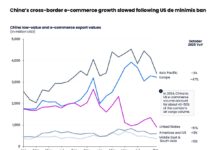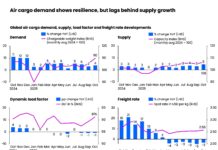Globalization remains at a record level, despite geopolitical tensions and uncertainties, say DHL and New York University’s Stern School of Business in the latest issue of the DHL Global Connectedness Tracker, published on 19 November.
In 2023, 21% of the value of all goods and services produced around the world was traded internationally – just shy of the all-time high of 22% first reached in 2008 and matched in 2022.
The Connectedness Report tracks how flows of trade, capital, information, and people move around the world, measuring international relative to domestic activity on a spectrum from 0% to 100%. Currently at 25%, it shows that globalization is holding steady at a record high, highlighting the resilience of international flows to geopolitical tensions and uncertainty. But it also indicates that, despite decades of globalization, the world is far from being completely connected.
DHL Express chief executive, John Pearson, said: “The Global Connectedness Tracker shows that there are still countless opportunities for countries and businesses to expand their markets across the globe. While the outlines of this complex landscape remain in flux, the fundamental drivers and benefits of international engagement endure. Global trade enhances international exchange and fosters opportunities to empower individuals, businesses, and allows entire nations to flourish.”
However, ties between the US and China continue to diminish. Direct trade between the two fell from 3.5% of global goods trade in 2016 to 2.6% in 2024 (January to July). However, direct trade between the US and China accounts for only a small part of the world total.
The Tracker also revealed that ‘unaligned’ countries that are neither close allies of the US nor China are conducting a growing share of world trade, developing new roles as connecting economies bridging geopolitical rivals. The share of trade involving countries that are not close allies of either superpower rose from 42% in 2016 to 47% in 2024, with the UAE, India, Vietnam, Brazil, and Mexico seeing especially large share gains over this period.
With the potential for new trade conflicts after Donald Trump’s return to the White House, the analysis suggests caution regarding predictions that such developments would reverse globalization. It is noted that, while actual policy changes in the US remain uncertain, international trade has remained resilient through Brexit, the US-China trade war, the Covid pandemic, and conflicts in Ukraine and Gaza.
Senior research scholar and director of the DHL Initiative on Globalization at NYU Stern’s Center for the Future of Management, Steven A. Altman, explained: “In turbulent times, it is essential to look beyond the political crossfire about globalization to make informed decisions based on how international flows are actually developing. While there is no guarantee that the recent resilience of global flows will continue, it highlights how companies and countries often find creative ways to preserve benefits they derive from globalization. As long as markets stay connected, a company that unilaterally retreats from globalization can put its competitive position at risk.”
Despite increased interest in producing goods closer to customers in recent years, the analysis indicates that regionalization is not overtaking globalization. In fact, most flows are taking place over stable or longer distances – which speaks against a broad shift towards regionalization. During the first seven months of 2024, traded goods even traversed the longest average distance on record (4,970 km). In line with this, the share of goods trade taking place inside major world regions fell to a new low of 51%.









